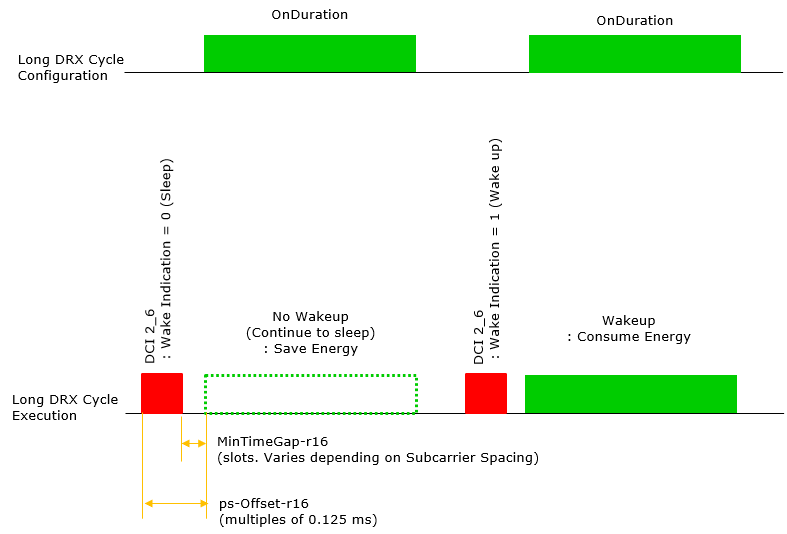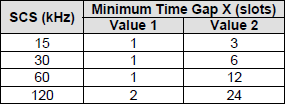|
|
||||||||||
|
WUS (Wake Up Signal) is a type of power saving mechanism introduced in NR release 16. I tries to save power by letting UE to continue to sleep (i.e, No Wake up) even for DRX OnDuration period when there is no data for the UE and gNB notifies the UE of 'No Wake Up'. When there IS any data for the UE, gNB would notify the UE of 'Wave Up' so that UE wakes up and receive data during OnDuration time. ProcedureThe detailed procedure for WUS mechanism is specified in 38.213 - 10.3 PDCCH monitoring indication and dormancy/non-dormancy behaviour for SCells. My simplied understanding of the process can be illustrated as below and I don't think I need to verbalize this illustration. I think (hope) the illustration itself is self explanatory.
UE CapabilitySince this is release 16 feature and there would already be a lot of release 15 device which does not support this feature, gNB should check whether the UE supports this feature or not. For this purpose, UE should inform gNB of its capability about WUS and followings are parameters in UE capability Information. MAC-ParametersFRX-Diff-r16 ::= SEQUENCE { directMCG-SCellActivation-r16 ENUMERATED {supported} OPTIONAL, directMCG-SCellActivationResume-r16 ENUMERATED {supported} OPTIONAL, directSCG-SCellActivation-r16 ENUMERATED {supported} OPTIONAL, directSCG-SCellActivationResume-r16 ENUMERATED {supported} OPTIONAL, -- R1 19-1: DRX Adaptation ... }
MinTimeGap-r16 ::= SEQUENCE { scs-15kHz-r16 ENUMERATED {sl1, sl3} OPTIONAL, scs-30kHz-r16 ENUMERATED {sl1, sl6} OPTIONAL, scs-60kHz-r16 ENUMERATED {sl1, sl12} OPTIONAL, scs-120kHz-r16 ENUMERATED {sl2, sl24} OPTIONAL } < 38.213 - Table 10.3-1 Minimum time gap value X >
Following is the description about drx-Adaptation-r16 described in 38.306. Indicates whether the UE supports DRX adaptation comprised of the following functional components:
DCI 2_6This DCI is used for notifying the power saving information outside DRX Active Time for one or more UEs. This is scrambled by PS-RNTI. Structure of DCI format 2_6 is as follows : block number 1, block number 2,, block number N Structure of each block is as follows :
The overall structure of DCI 2_6 is as shown below (Source : Figure 11 of Ref [4])
RRC ParametersFollowings are RRC parameters directly or indirectly related to WUS. You see huge list of parameters here, but DPC-Config-r16 (marked red) is the most critical parameters.
DRX-Config ::= SEQUENCE { drx-onDurationTimer CHOICE { subMilliSeconds INTEGER (1..31), milliSeconds ENUMERATED { ms1, ms2, ms3, ms4, ms5, ms6, ms8, ms10, ms20, ms30, ms40, ms50, ms60, ms80, ms100, ms200, ms300, ms400, ms500, ms600, ms800, ms1000, ms1200, ms1600, spare8, spare7, spare6, spare5, spare4, spare3, spare2, spare1 } }, drx-InactivityTimer ENUMERATED { ms0, ms1, ms2, ms3, ms4, ms5, ms6, ms8, ms10, ms20, ms30, ms40, ms50, ms60, ms80, ms100, ms200, ms300, ms500, ms750, ms1280, ms1920, ms2560, spare9, spare8, spare7, spare6, spare5, spare4, spare3, spare2, spare1}, drx-HARQ-RTT-TimerDL INTEGER (0..56), drx-HARQ-RTT-TimerUL INTEGER (0..56), drx-RetransmissionTimerDL ENUMERATED { sl0, sl1, sl2, sl4, sl6, sl8, sl16, sl24, sl33, sl40, sl64, sl80, sl96, sl112, sl128, sl160, sl320, spare15, spare14, spare13, spare12, spare11, spare10, spare9, spare8, spare7, spare6, spare5, spare4, spare3, spare2, spare1}, drx-RetransmissionTimerUL ENUMERATED { sl0, sl1, sl2, sl4, sl6, sl8, sl16, sl24, sl33, sl40, sl64, sl80, sl96, sl112, sl128, sl160, sl320, spare15, spare14, spare13, spare12, spare11, spare10, spare9, spare8, spare7, spare6, spare5, spare4, spare3, spare2, spare1 }, drx-LongCycleStartOffset CHOICE { ms10 INTEGER(0..9), ms20 INTEGER(0..19), ms32 INTEGER(0..31), ms40 INTEGER(0..39), ms60 INTEGER(0..59), ms64 INTEGER(0..63), ms70 INTEGER(0..69), ms80 INTEGER(0..79), ms128 INTEGER(0..127), ms160 INTEGER(0..159), ms256 INTEGER(0..255), ms320 INTEGER(0..319), ms512 INTEGER(0..511), ms640 INTEGER(0..639), ms1024 INTEGER(0..1023), ms1280 INTEGER(0..1279), ms2048 INTEGER(0..2047), ms2560 INTEGER(0..2559), ms5120 INTEGER(0..5119), ms10240 INTEGER(0..10239) }, shortDRX SEQUENCE { drx-ShortCycle ENUMERATED { ms2, ms3, ms4, ms5, ms6, ms7, ms8, ms10, ms14, ms16, ms20, ms30, ms32, ms35, ms40, ms64, ms80, ms128, ms160, ms256, ms320, ms512, ms640, spare9, spare8, spare7, spare6, spare5, spare4, spare3, spare2, spare1 }, drx-ShortCycleTimer INTEGER (1..16) } OPTIONAL, -- Need R drx-SlotOffset INTEGER (0..31) }
DRX-Preference-r16 ::= SEQUENCE { preferredDRX-InactivityTimer-r16 ENUMERATED { ms0, ms1, ms2, ms3, ms4, ms5, ms6, ms8, ms10, ms20, ms30, ms40, ms50, ms60, ms80, ms100, ms200, ms300, ms500, ms750, ms1280, ms1920, ms2560, spare9, spare8, spare7, spare6, spare5, spare4, spare3, spare2, spare1} OPTIONAL, preferredDRX-LongCycle-r16 ENUMERATED { ms10, ms20, ms32, ms40, ms60, ms64, ms70, ms80, ms128, ms160, ms256, ms320, ms512, ms640, ms1024, ms1280, ms2048, ms2560, ms5120, ms10240, spare12, spare11, spare10, spare9, spare8, spare7, spare6, spare5, spare4, spare3, spare2, spare1 } OPTIONAL, preferredDRX-ShortCycle-r16 ENUMERATED { ms2, ms3, ms4, ms5, ms6, ms7, ms8, ms10, ms14, ms16, ms20, ms30, ms32, ms35, ms40, ms64, ms80, ms128, ms160, ms256, ms320, ms512, ms640, spare9, spare8, spare7, spare6, spare5, spare4, spare3, spare2, spare1 } OPTIONAL, preferredDRX-ShortCycleTimer-r16 INTEGER (1..16) OPTIONAL }
PhysicalCellGroupConfig ::= SEQUENCE { .. dcp-Config-r16 SetupRelease { DCP-Config-r16 } OPTIONAL, -- Need M ... }
}
ServingCellConfig ::= SEQUENCE { dormantBWP-Config-r16 SetupRelease { DormantBWP-Config-r16 } }
DormantBWP-Config-r16::= SEQUENCE { dormantBWP-Id-r16 BWP-Id OPTIONAL, -- Need M withinActiveTimeConfig-r16 SetupRelease { WithinActiveTimeConfig-r16 } OPTIONAL,-- Need M outsideActiveTimeConfig-r16 SetupRelease { OutsideActiveTimeConfig-r16 } OPTIONAL-- Need M }
WithinActiveTimeConfig-r16 ::= SEQUENCE { firstWithinActiveTimeBWP-Id-r16 BWP-Id OPTIONAL, -- Need M dormancyGroupWithinActiveTime-r16 DormancyGroupID-r16 OPTIONAL -- Need R }
OutsideActiveTimeConfig-r16 ::= SEQUENCE { firstOutsideActiveTimeBWP-Id-r16 BWP-Id OPTIONAL, -- Need M dormancyGroupOutsideActiveTime-r16 DormancyGroupID-r16 OPTIONAL -- Need R }
DormancyGroupID-r16 ::= INTEGER (0..4) Does it realy save a lot of Energy ?This is a big question. I think I saw some TR says it would save huge amount of energy (TR 38.840 - Table 7: Power saving scheme with UE adaptation to the DRX operation), but I personally think how much energy WUS can save would depend on use cases. To be honest, I am a little bit in doubt about such a huge energy savings in reality. Let's think of a few typical use cases: (NOTE : this is just my personal opinion based on my speculation, not based on any real test)
: I don't think there would be much energy saving effect of WUS since there would almost be no time for UE to fall into drx. UE would stay wake up all the time.
: Obviously this mode would comsume much less energy, but this is the state where WUS is not applicable.
: I think this would be the most typical case where WUS is applicable. But even in this case.. if the pause between the data traffic burst is large (like over 10 seconds), most of live network gNB would simply release RRC and put the call into idle mode to save more energy. One disadvantage of RRC Idle in this case is that it needs to do RRC setup process again when the next data burst comes which consume more energy. so depending on how to optimize gNB side operation (e.g, using more of WUS rather than releasing RRC even when the pause between data bursts are long), you may enjoy more energy saving. Opinion from other expertsWhile I didn't have such a bright opinion about the practical impact of WUS in terms of power saving, there can be other experts who has different opinion from mine. First I would like to introduce one of those opinion from Sean Cho. If any of you have opinion or experience on this and want to share yours, please email me or chat with me in linkedIn. Especially in NSA where both LTE and NR should be running simulteneously. Complete sleep on NR (no PDCCH monitoring) during drx-onDuration when there is no data, it is expected to have high gain in terms of energy saving. Reference :[1] The 5G Evolution:3GPP Releases 16-17 (5G Americas) [2] RP-200494 - UE Power Saving in NR (Work Item Description) [3] TR 38.840 - Study on User Equipment (UE) power saving in NR [4] Power Saving Techniques for 5G and Beyond [5] Novel Wake-up Scheme for Energy-Efficient Low-Latency Mobile Devices in 5G Networks YouTube
|
||||||||||


